Best in Class
Why the Porsche Grand Prix in Stuttgart races past the competition at the varied 500 level of the tennis tours.
As I was looking at the tennis tours’ offerings this week, I thought back—as one does—to the 1996 Cyranoesque rom-com The Truth About Cats & Dogs.
After the jerky boyfriend of Uma Thurman (Noelle) breaks the violin bow of her neighbor Janeane Garofalo (Abby), Noelle explains how she went shopping for a replacement to give Abby.
“Did you know violin bows were like cars?” Uma Thurman muses. “They go from your basic, low-end bows—something like a Geo or a Hyundai, which I personally drive—all the way to your high-performance, Porsche-like bows which play like the devil. I got you this…it’s like a Toyota, which was all I could afford.”1
ATP and WTA 500 events, I realized, could also use Uma’s violin bow scaling: there’s a clear range of quality in the products, and the Porsche one stands out as a best-in-class outlier.
The Porsche Grand Prix, the WTA 500 event played on indoor clay in Stuttgart, has been blowing past the rest of the middle-range events for years in terms of strength of field.
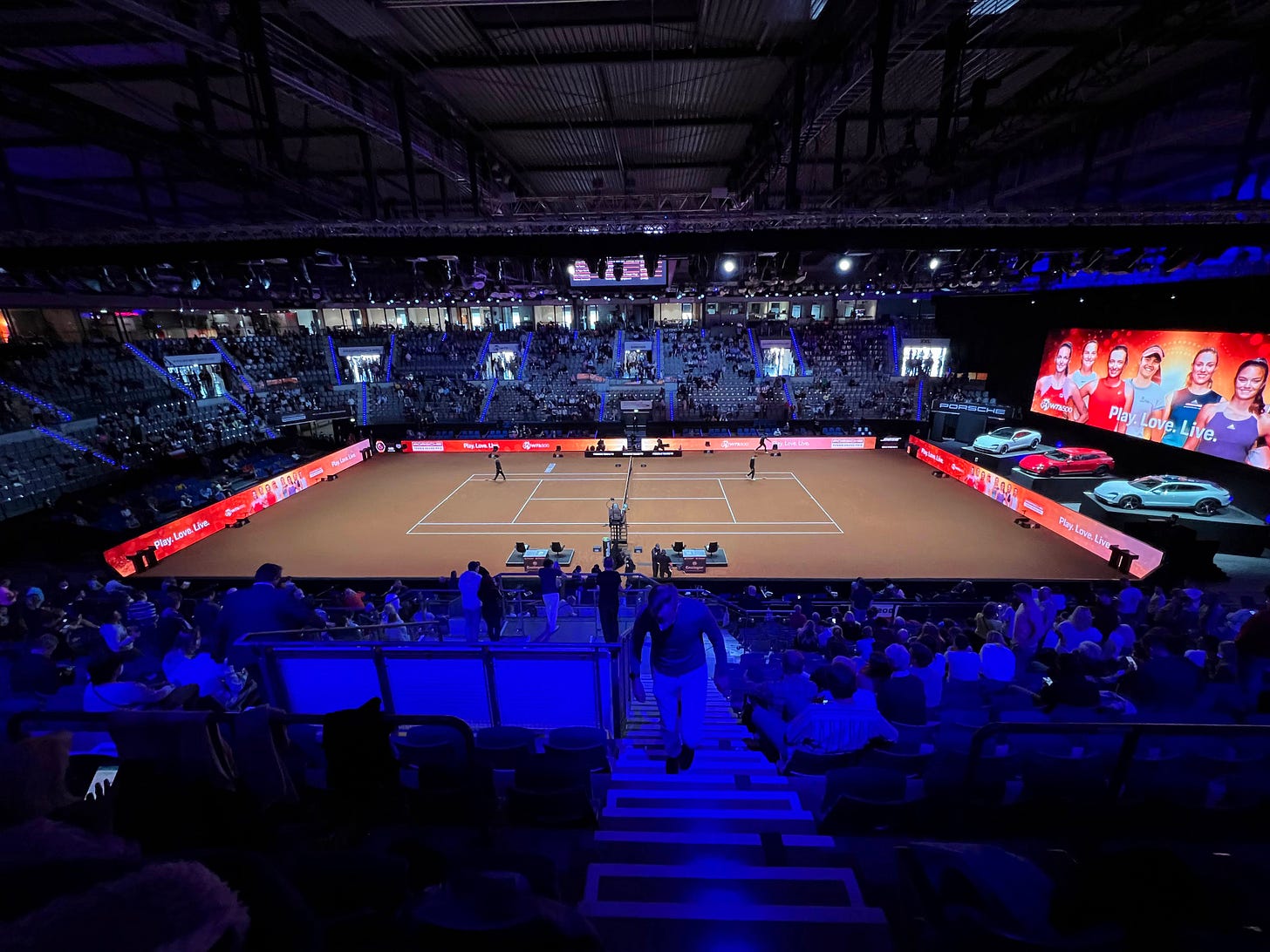
Stuttgart shifted from an autumnal indoor hard court tournament to being a rare indoor clay court event in 2009; since then, top players have reliably raced to Stuttgart every year. The top-line strength of the field is often more on par with WTA 1000 events than others in the WTA 500 category.
Aside from lucrative appearance fees—and the lure of the champion winning a new Porsche—the tournament also offers luxurious on-site amenities and service to players and their teams.
“A look at the list of stars that have confirmed their entries is for me proof that the total package we offer the players is spot on,” Stuttgart tournament director Markus Günthardt said in 2023. “We’re not one of the really big tournaments, we don’t have the biggest prize money and not the most world ranking points, but nevertheless the world’s best players come to us. It’s a fantastic statement telling us that they like being here.”
The Dashboard Panels of a 500 Event
500-level events, which fall between 250s and 1000s on the WTA and ATP tours, are an interesting class of events to look at in isolation, since many factors go into their success or failure. They’re lucrative but not mandatory, and their place on the calendar and the appearance fees they offer can both play huge roles in how they succeed or fail to attract top players.
There’s a few different ways to measure the strength of a tournament field, but I think one of the most uniform is to use the rankings of the Top 8 seeds at the time the draw is made (rankings which are preserved for posterity on the drawsheet), so that’s what I’m doing in this piece.
First, let’s look at just how consistently overpowered WTA 500 Stuttgart has been through the rankings of its seeds, with at least six top-10 players every year.
Stuttgart has reliably punched well above its weight, as you can see. In 2012, the Top 8 seeds matched the Top 8 in the WTA rankings. In 2017, it was 8 of the top 9, with only the on-maternity-leave Serena Williams missing out. (That Serena never played in Stuttgart during its clay incarnation2 makes the above chart even more remarkable).
To put Stuttgart’s sea of green in greater context, here’s what the seeds have looked like at other 500-level events over the past 52 weeks, sorted in chronological order on the tennis calendar. Two notes on this chart: I’m including the United Cup in this event since the WTA counts it as a 500-level event (and its seeds fall within the 500 range), and I’m using the 2023 data for Washington since the 2024 edition was abnormally depleted because it was simultaneous with the Paris Olympics (more on this at the end of this piece).
And here’s the chart sorted by the median of the Top-8 seeds, which further reveals Stuttgart and its grassy neighbor in Berlin as the standouts.
You could reasonably argue that mean is a better insight than median for this data, since it puts all eight seeds in play rather than just No. 4 and No. 5; Stuttgart is actually very narrowly edged out by Berlin in this 52-week cycle when using the mean.3
Except for the slightly wonky United Cup, all of these events uniformly award 500 points to the champion (and 325 points for runner-up, etc). But as you can see, there are very different degrees of expected difficulty to earn those points.
And some expected draws hold up while others collapse, increasing the variability of the paths.4
Let’s take two extreme examples: last year, Marta Kostyuk faced four top-10 players during her runner-up run in Stuttgart.
By comparison, Emma Navarro didn’t need to face a single top-40 player en route to 500 points this year in Merida.
Navarro shouldn’t get knocked for taking a softer path to 500 points; if anything, it’s a savvy bit of scheduling. That savviness should perhaps be something more players seek to replicate for a competitive advantage, especially as the WTA recently increased the required number of 500-level tournaments to six each season for players between ages 18-33.
What Top Tennis Folks Say About 500s
The variability has increased in recent years as the WTA has expanded from 12 to 18 events at the 500-level, with many of the newer events at this tier disproportionately represented at the bottom of the sorted chart.
When I was at the strong WTA 500 event in Charleston earlier this month, I asked a couple relevant folks about the varied landscape of 500 events.
Charleston’s top seed and eventual champion Jessica Pegula—who also won the super-tough WTA 500 Berlin last year—was up on the topic as a longtime member of the WTA Player Council.
“Since a lot of the [500] tournaments decided to upgrade and all this is fairly recent and new, it's kind of like getting a little bit of a grip on which weeks are going to be tough, which weeks aren't going as tough,” Pegula said. “I remember playing Berlin last year, it was like everybody in the Top 10 was entered, and it was crazy. Here [in Charleston] I feel like the draw is also really, really strong, considering it's the first week and we're on green clay in the U.S. But, yeah, it's interesting when that kind of shifts.
“I mean, the 500s are so tough because the draws are usually a little smaller, so you're playing someone really good first or second round already,” Pegula continued. “I think it's almost just as hard to win those as it is to almost win 1000 in a sense just because you don't have a lot of time to kind of get your game under you. You just have to go out there and play a top seed kind of right away. So that always makes it different and I think tough, but yeah, it's just a little bit of an adjustment knowing that maybe more tournaments like that you just don't have as much time to kind of work your way into a draw.”
I then asked Pegula if she ever intentionally tried to make a schedule of softer tournaments that would make ranking points easier to scoop up.
“I mean, maybe, yeah,” Pegula replied. “I think some people do that, if you want more matches or you know it's going to be weaker, for sure. There's for sure girls that do that just for getting in [to qualifying or main draw]. Like Berlin—let's just use that as an example—they know it’s going to be really tough to get into. Stuttgart is really tough to get into; girls have trouble getting into qualies there. So in that sense, for sure, you definitely look at which weeks are stronger and maybe not.”
Charleston’s tournament director Bob Moran, whom I interviewed about a whole host of topics for Bounces as you might have read last week already, represents the 500-level on the WTA Tournament Council, and spoke about the WTA’s interest in making sure events at that level can maintain quality control.
Here’s that previously-unpublished part of our interview which I saved for this piece:
Ben Rothenberg, Bounces — I want to ask about the 500 level actually, because you guys [Charleston] have been at that level for a while, and there’s been a big uptick in the number of 500 events. I think it went from like 12 to 17 in the last couple of years.
Bob Moran — 18. [Moran later clarified he’s counting the United Cup as a 500-level event, which I hadn’t]
Ben Rothenberg, Bounces — Okay, 18 now, even. How does that affect this event, having so many more 500s on the calendar?
Bob Moran — It doesn’t affect us [Charleston]; it is something we’re paying attention to. Last year was the first year of having 18 on the schedule, and being able to provide enough players and product to make every 500 field that elevated player field.
The Olympics would’ve made that really challenging last year. The Olympics was like having another 1000 in the middle of the season, which made it really tough on the players. Surface flow wasn’t great, calendar flow wasn’t great. All of those things affected the players and we saw that at the end of the year.
Ben Rothenberg, Bounces — I think you’re still seeing it a bit now. People have talked about that there still could be an Olympic hangover going on for some players.
Bob Moran — It wouldn’t surprise me. So I think this year is the first year we’re really getting a good read on how those additional 500s affect calendars, how it affects player schedules, things like that. For us, we know what we have to do to be successful, and I think we’ve stuck to that playbook pretty consistently. And it’s worked again this year: we have a great field, and we’re happy where we are.
Ben Rothenberg, Bounces — I guess you guys [Charleston] haven’t changed much, but I feel that there’s a big range in the fields these 500s get.
Bob Moran — Yes.
Ben Rothenberg, Bounces — Between, let’s say, Stuttgart and Charleston probably on the upper end and then, like, Linz or Merida on the lower end in terms of not getting many top players. How do you think that affects things where there’s very different paths you have to go through to get 500 points as the champion?
Bob Moran — Yeah, it’s very true. And you’ve named two events that we’re taking a look at. We’re making sure, and we have to look at it this year, right? Merida didn’t have much of a chance last [month]; they quickly shifted from San Diego to Merida late in the game, so they didn’t really have a great chance to build a field. What I know about the [Merida tournament-owning family] Santascoys: they do a really good job. They’ve done a great job in Guadalajara; they did a great job in Merida. I think they will be able to build that.
Linz is just tough. It’s a tough date. So we’re hoping that we can see a shift, but it’s a tough date. We understand calendars.
So I think it’s evolving. We’re going to work closely with the players and the tournaments to make sure this works. And if it doesn’t, then we have to go back to the drawing board and start to take a look. But we want to see the data after this year and see how it works out, because the Olympic year wasn’t a fair year to really evaluate it.
How 500s Stack up on the Men’s Side
This week is also a good occasion to discuss the 500-level on the men’s side of the aisle, since the two ATP events this week are both 500s: the longstanding ATP 500 Barcelona and the newly-upgraded ATP 500 Munich, in its first year at the tier after being promoted from a 250.
One of these events is much stronger than the other, as you can first see in this chronological table.
The ATP calendar has far more simultaneous pairs of 500 events (something the WTA had none of until recently), pitting several tournaments directly head to head: Rotterdam-Dallas; Doha-Rio de Janeiro; Dubai-Acapulco; Barcelona-Munich; London-Halle; Tokyo-Beijing; and Vienna-Basel. There’s often a clear winner and loser of these head-to-heads.
And here are the ATP 500 seed tables sorted by median Top-8 seed and then mean Top-8 seed. As you can see, nothing is quite on WTA 500 Stuttgart’s level.
A few takeaways from these ATP tables, with some WTA observations as well:
This goes for the women, too, but I was struck looking at these how rarely the No. 1 ranked player has shown up for a 500-level event in the past year: only twice for the ATP and twice for the WTA. But it’s worth pointing out that if Jannik Sinner hadn’t withdrawn right before the draw was made in Doha to take the suspension he was offered, that event would’ve had the strongest mean Top-8 seeds mean on the ATP calendar, at 7.4. On the women’s side, you may remember that then-No. 1 Iga Swiatek playing so few 500-level events in 2024 contributed to a ranking penalty that cost her the No. 1 ranking late last season.
ATP 500 Halle and WTA 500 Berlin both being near the tops of their respective lists is not a coincidence: that middle week of the three-week grass warm-up swing between Roland Garros and Wimbledon is a sweet-spot week in which every top player would want to play to prepare for Wimbledon with ample rest after Paris and before London. Part of what makes WTA 500 Stuttgart’s success so impressive is that it isn’t in as obvious of a sweet spot on the calendar. Also, Germany is the Land of 500s, with three on each tour; Mexico is also overrepresented with four 500s across the two tours, but theirs are considerably weaker on the women’s side.
It’s unsurprising that the two weakest ATP 500-level events are clay court events that are outside of the main clay court season. What is more remarkable, however, is that the three weakest ATP 500 events (Munich, Hamburg, Rio de Janeiro) were the only ones that had just one top-10 player appearing…and each of the three times, that lone top-10 player was Alexander Zverev.
A Last Word on ATP-WTA 500 Washington
I agonized and waffled more than I probably needed to about which year’s data to use for my hometown event of Washington in these charts, and figured that in the name of transparency I should show what it would have looked like if 2024’s Olympics-interfered data was used instead of 2023.
Washington became the only combined ATP+WTA 500 level event in 2023, and it’s tough to know what its future holds in terms of the field it can attract. This year, because of Canada and Cincinnati spreading across an additional week, Washington will begin just one week after Wimbledon concludes; there will again be a two-week gap restored in the 2026 calendar. I think the jury is still out on which sample might prove more indicative long-term.
Thanks for reading Bounces! If you want more of these nerdy deep dives into the structure of tennis, and the landscape of the tour, please do subscribe; if you reached the end of this article, I guarantee you are my target audience, and there are many pieces like this one already available behind paywalls in the Bounces archives that you’ll enjoy! -Ben
P.S.: Thanks to all of you who recently subscribed to bump Bounces into the trending top-10 on Substack Sports!
If you’re into this sort of thing, RemingtonA and I are co-authoring a LearnedLeague mini league this summer on 1990s RomComs!
Serena did play Stuttgart twice back when the event was on hard courts, including a debut match in which Zuzana Ondraskova gave her a scare.
Berlin’s hold on the top spot could be short-lived; this year there will also be a WTA 500 event the week before it as well, as women’s tennis will return to London’s Queen’s Club for the first time in decades. That could possibly lure some players away, but Berlin is still in that sweet-spot week.
WTA 500 Ningbo especially collapsed; the top-three seeds all pulled out before their first match, so the tournament probably deserves to be lower on the charts.





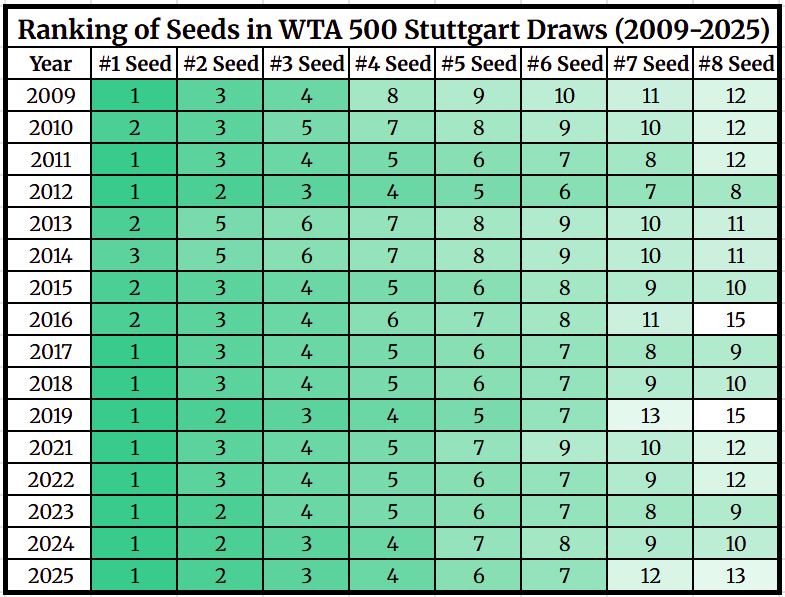
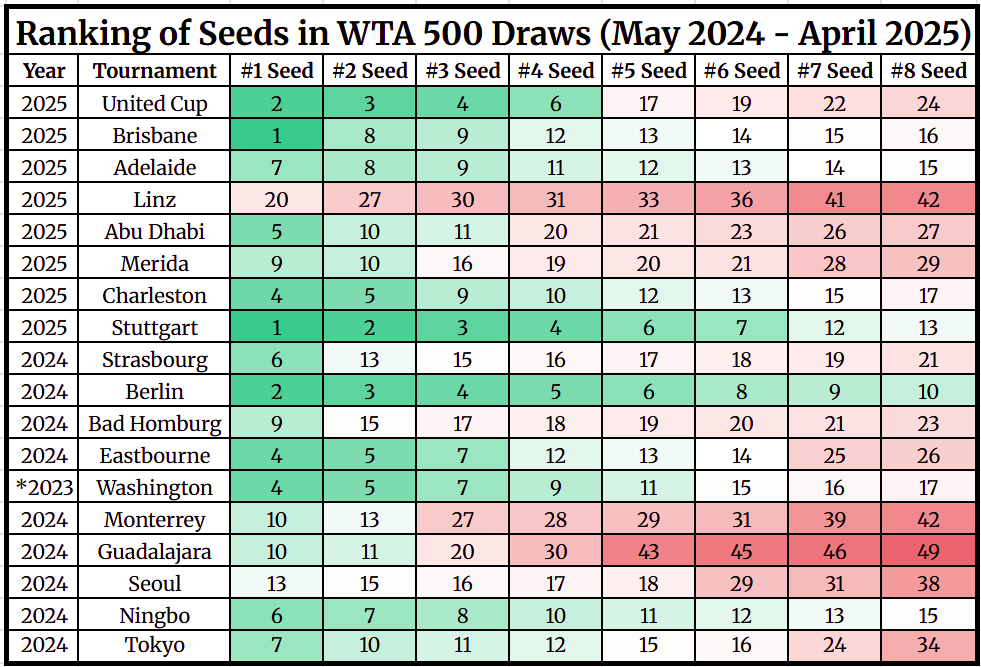
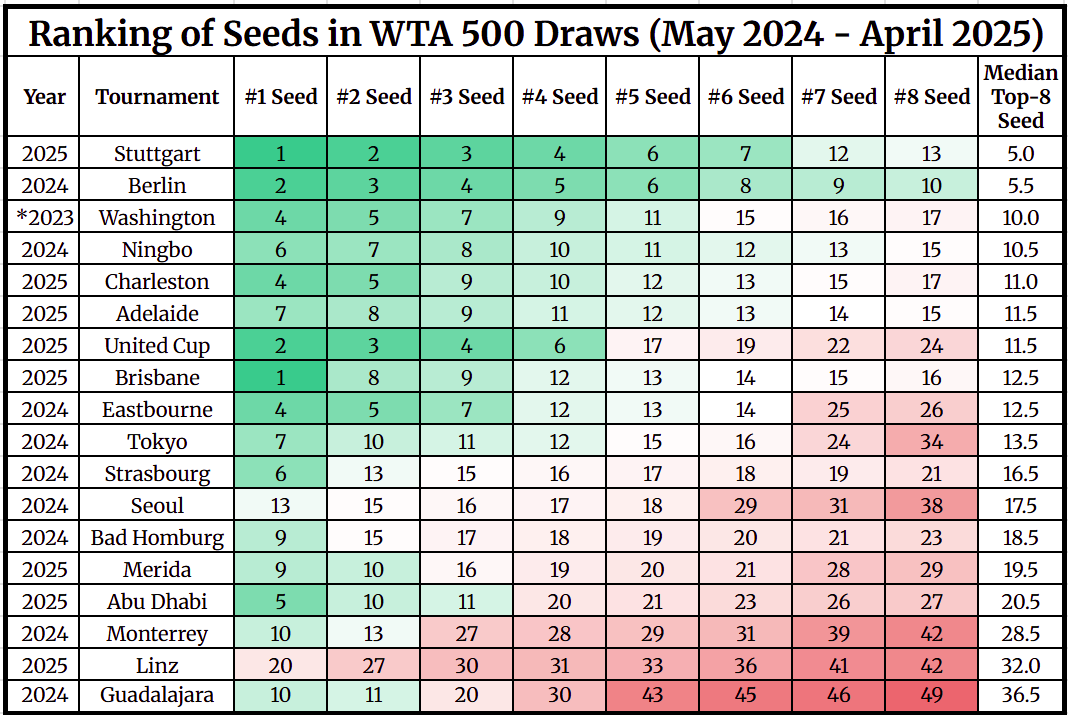
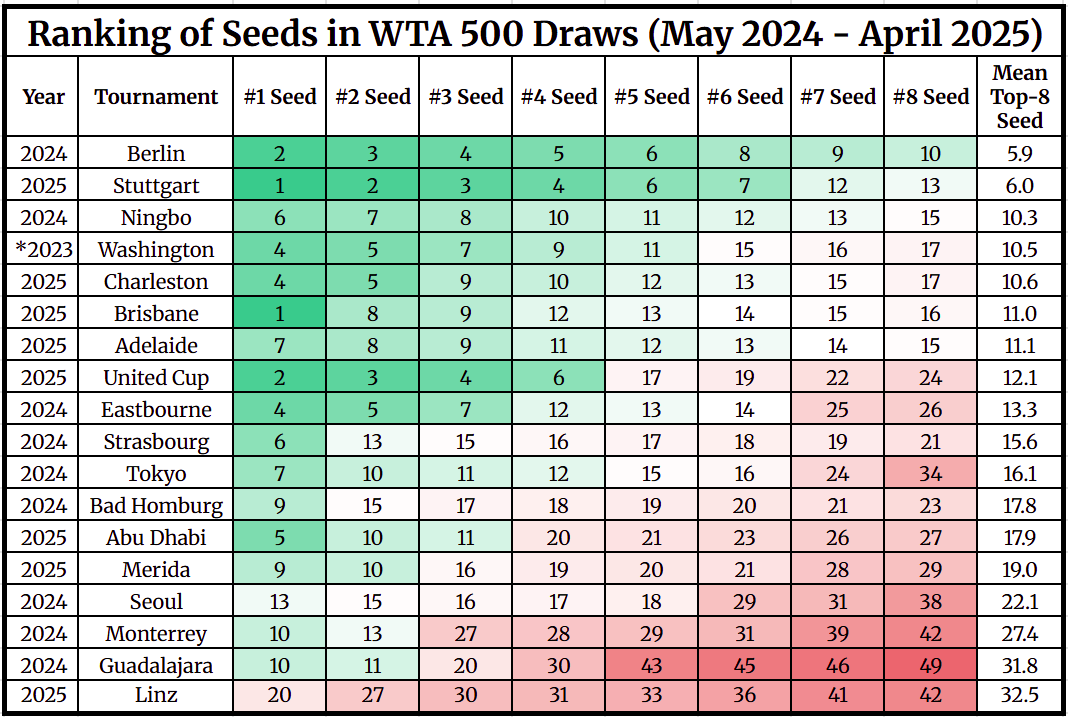



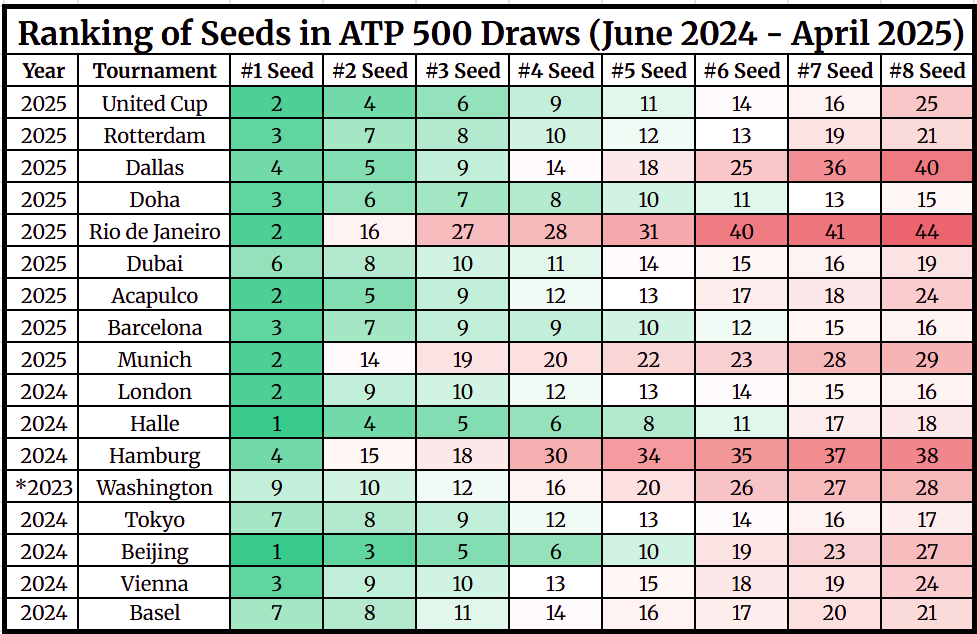
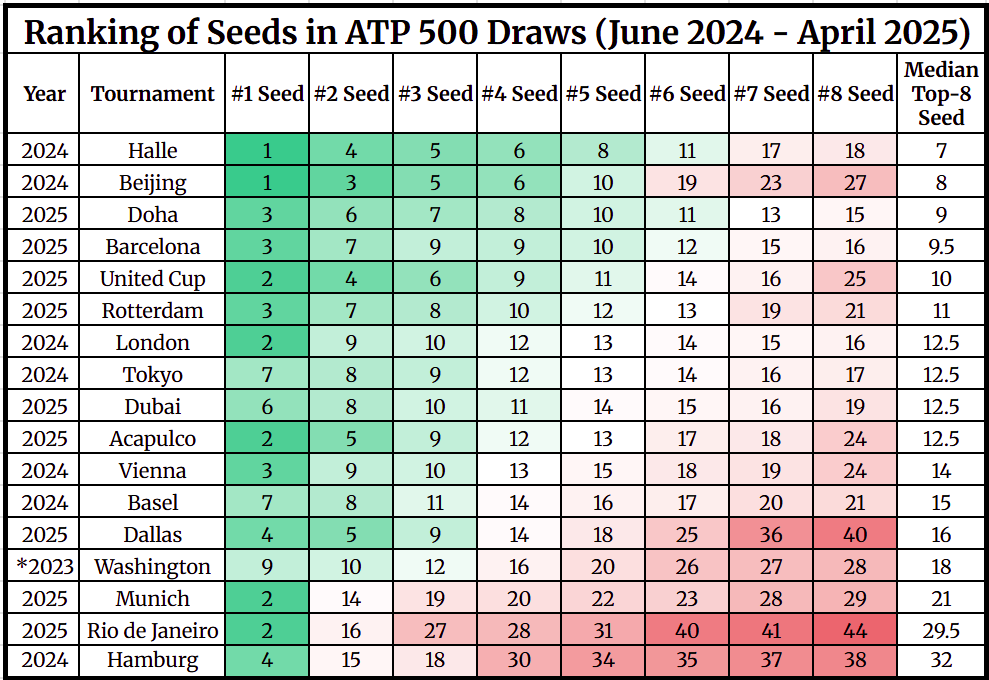




Ben, thanks for the research!
Don't like these first rounds byes for the top-4 seeds we have this week in a 500 32-player draw: getting 108 points for winning just 1 match is too much. Otherwise, Stuttgart usually has great fields, excellent visuals/camera angles and a very high level of play.
Regarding ATP 500s scheduled head-to-head, I recall reading that income taxes can impact which tourney the top players choose to enter, specifically Halle vs London.
I went to my first Citi Open in Washington in 2019 and was lucky enough to watch Jessica Pegula win her first WTA title, Coco Gauff and Caty McNally won doubles, and fan favorite Nick Kyrgios won the men's side. It's a great event in a wonderful city. I can't recommend it enough.